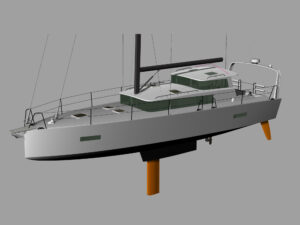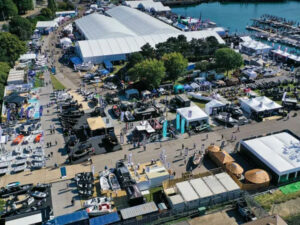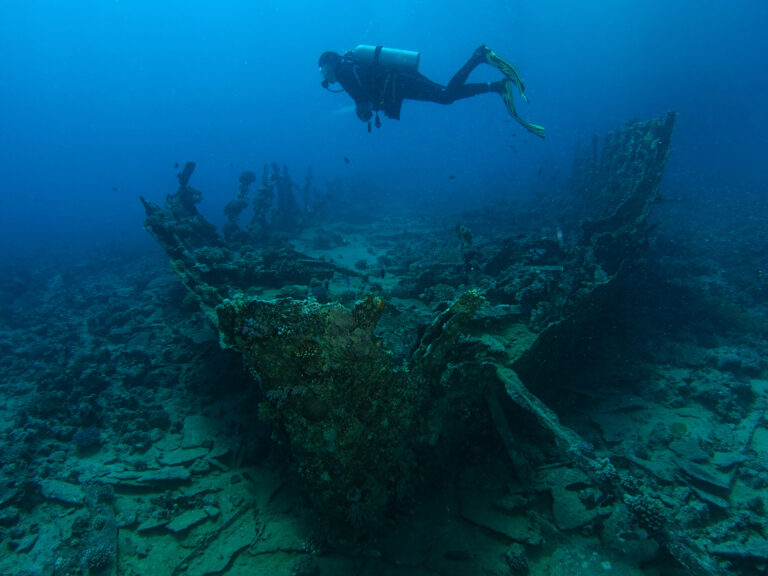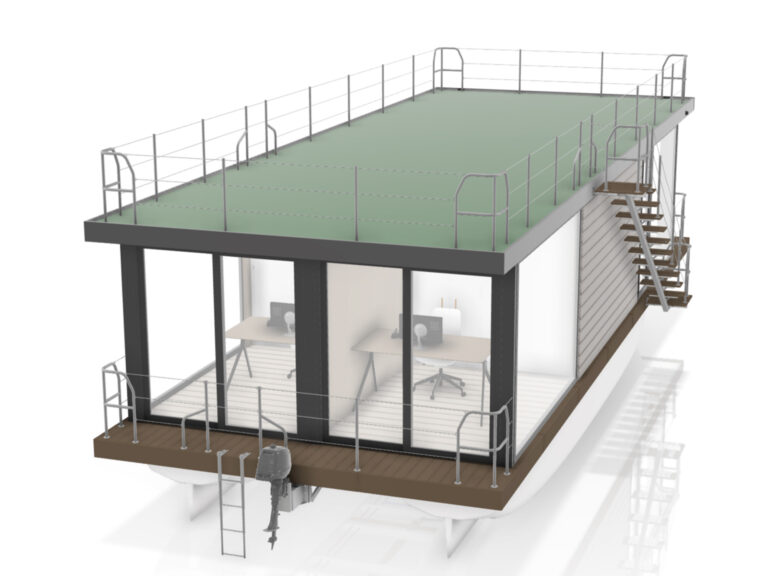We love getting e-mail ([email protected]) from readers, finding out what you’re doing and thinking, which Logs tickle, which annoy, and what you want to hear more about. It’s peculiar for two generally private people to be writing about their lives in public, but thinking about and writing our Log has become part of what this voyage is to us, a piece of the week devoted to integrating something that may have startled our reality a little, and then passing it along. Many thanks for your encouragements, and for sharing your own stories and cruising plans with us. Here are several e-mail questions that, in one form or another, we’ve received from different sailors over the past month.
| | Douglas on the dock at Tortugal* * *| Reece F., from Southamptom, England, wrote “My wife and I are at our eight-month countdown. The house is for sale, the boat is almost ready, and so are we. I got a kick out of Douglass pleasure reading list, but could you also mention which practical books have proved to be the most valuable for you as ongoing resources?”
From Douglas: That’s easy. The first two are by Nigel Calder. His encyclopedic Boatowners Mechanical and Electrical Manual, which is found on most cruising-boat bookshelves, is, for those of us who didn’t spend our previous lives working full time in boat yards ( I sometimes wish I had), the most complete discussion of every major system on your boat. Calder goes into how they’re designed, the theories on which they’re based, what the regular maintenance needs are, how to perform them, what breaks most often, how to troubleshoot and diagnose problems, and how to fix them. I find Calder and his book both overwhelming and invaluable. How CAN one man know so much? He’s the guy I first turn to when something needs attention and I’m not sure how to go about it. His pictures and drawings are a godsend when trying to figure how something you took apart “ought to look” as you attempt to re-assemble it. Sometimes I’ve had to read sections a dozen times to grasp them, but that’s just the reality of learning new material. Nigel’s dry as dust, so go elsewhere for your high-octane reading, or think about each project as if you’re the knight on a quest for the mechanical grail.
| | The belly of the beast* * *| _Refrigeration for Pleasure Boats_, also by Nigel Calder, is nothing less than the Bible, Talmud, Koran, Book of Tao for refrigeration systems. When we moved aboard _Ithaka_, what I knew about refrigeration wouldnt have filled one cube in an ice tray, but Calder made it possible for me to understand enough about refrigeration to risk, finally, tackling the job of fixing a dead unit. That alone is a colossal endorsement for any book. He takes you step-by-step through every kind of refrigeration system. While this is not the kind of book I ever would have bought in our land lives, now I actually enjoy reading through it. Such is the nature of how things change. If you want to work on your own fridge, this book is a necessity. Because we had it on board, now we have cold food again.
Kathy Parson’s_ Spanish for Cruisers: Boat Repairs and Maintenance Phrase Book_ is a practically laid out and tabbed manual that’s far more poetic than its modest, utilitarian title suggests. This book is packed full of what almost all reference books lack, wit and perspective. In addition to essential phrases for everyday chit-chat, she’s divided this handy gem into 25 sections that cover in detail every mechanical system or part on your boat: propane, stove, refrigeration, engine parts, structural terms, basic conversation with officials over the radio, getting along with workers in a boatyard. As a further commentary on how life has changed, I sometimes use her book to practice sentences and questions with Bernadette before going into a town to find parts. And I always take Kathy Parson with me in the knapsack, because once ashore, even if I mangle the words, I can point to her drawings and translations. She’s been cruising for many years and before that was a Spanish teacher. For my money, she still is. You can order it from Aventuras Publishing Company, Rt. 4 Box 180, Hallettsville, Texas 77964, or you can contact the author by email or phone: [email protected] (361) 798-4159.
| Maria M., from Austin, Texas, emailed us that she and her husband are quitting their jobs and heading this way next year on their Hunter 42, Milano. Maria asks, “How do you handle the laundry chores in the Western Caribbean? Are there laundromats?”
From Bernadette: Laundry will never be more a part of the rhythm of your daily life than it is when you go cruising. No matter what your level of laundry activity was at home, cruising laundry is another animal altogether You’ll encounter the smelliest bag of grease-stained, sweaty, dank clothing that you can imagine, and you’ll shudder to think you ever had any of it on your back. Meanwhile, around you, everyone is dealing with laundry: most cruisers you meet are lugging it around and stringing it up on lifelines, shrouds and rigging. On land, laundry it hangs on clotheslines in front of everyone’s village homes; in Guatemala, this often means yards and yards of their beautifully hand-woven fabrics — quite a pretty sight! You see local women on the Rio doing laundry morning, noon and night along the side of river; they hike up their skirts, wade into the water up to their thighs, and scrub the clothes with a bar of soap against the rocks. Indeed, down here, when an Indian woman asks a man if she can do his laundry, it means a serious commitment. (When I ask Douglas if I can do his laundry, it means eau de honey is beginning to permeate de boat.)
| | In Isla Mujeres, Mexico* * *| In the Third World, most towns dont have laundromats hence the 500 million white cotton diapers you see hanging out on clotheslines in every little town you hoof through. So you bring your laundry to someone who usually has a hand-written sign in her window, she does it for you using her products, and you pick it all up a few hours later or the next day. Its usually pretty reasonable. In the Rio, each marina has laundry facilities.
When were at anchor, however, I do basic laundry by hand in a bucket. (Soak for awhile in freshwater and detergent, then scrub, rinse, hang on the lifelines, and use the leftover water to wash the cockpit cushions.) I kind of enjoy the whole process, as it makes my hands feel super clean for about 42 seconds. By the way, heres a tip: Have a few extra fitted sheets made for your bed. Ive just had two more sets of fitted sheets made by a seamstress in the Rio, as we only had two sets onboard this past year. When youre hot and sweaty, you really need to change the sheets and pillowcases every week, and when youre anchored off deserted islands for a month or more at a time, trying to conserve your fresh water, you cant afford to wash sheets that often; they take too much water. Now we have four pretty sets and can leave the washing of sheets until we get back to shore.
| | The marimba at AkTenamit, Rio Dulce* * *| Mark L, from Quebec, sails with his wife, Lorena, on their 1983 Valiant 40. They plan to take off in two years for an open-ended cruise. He asked, “How hard is it to get boat parts once you leave North America?”
From Douglas: Here in the western Caribbean, it depends on where you are. Cuba doesn’t have ship chandleries; they barely have soap and toothpaste. What they do have, though, are shade-tree magicians who can successfully transplant a Russian tractor diesel into a Studebaker and keep it on the road for half a century, so chances are pretty good they can handle mechanical work for you and fabricate whatever you need for engines. For almost everything else forget it. The parts just aren’t there.
In the Mexican Yucatan, Cancun has everything you could possibly need, and the marina in Isla Mujares can do whatever work you want and order parts flown in. In Belize, theres a pretty well stocked marine supply house in Belize City, and they can order for you, but that always takes time.
In Guatemala, Puerto Barrios is a port town with basic industrial supply shops of all kinds and workers in all the trades. But its not a place to find yacht paraphernalia. The capitol, Guatemala City, has a pretty good selection of anything mechanical, and Mar Marine, in the Rio Dulce, is a very-very-mini-mini version of West Marine. Rio Dulce also sports a small used parts store, run by a former cruiser. In the Bay Islands and Honduras, theres the navy haul-out yard at Puerto Cortez, but its more for rough labor than fine work. Theres a haul out facility (100 ton travel lift) in La Ceiba, and they have full service, some parts, and can place special orders.
| | Crabs woven with palm leaves, for sale in San Pedro* * *| The specialized odds and ends that constitute modern yachts are by and large not available around here. Many can simply be done without, but if there are things that must be had, which can be found only in industrialized nations, by far the two easiest ways to get them is either to go there on your own and carry them back by bus, or on the airplane (we recently carried an entire radar system); or by have a visiting friend haul the stuff in person with a low declared value. Its expensive to have things shipped by Fed Ex or DHL, but it can be done reliably, and most marinas and boat yards will accept packages for you.
The problem some folks run into when they order replacement parts or gear, and have it shipped into a foreign country, is clearing the package through Customs. Worldwide, workers in this profession consistently prove that, other than how they like to play dress up, theres no discernable difference between cops and robbers. Depending on the vagaries of the country, there may or may not be significant tariffs levied on equipment sent in, despite that its been marked “For Yacht In Transit” (which is supposed to mean tariffs are waived). Weve heard of people paying anywhere from 10 to 40 percent of face value to get their stuff through customs. The costs may go down if you have a local agent process everything for you. Sometimes its merely a matter whom youd rather pay the mordita to, the government crooks or the civilian crooks.
The bottom line is the water line. Many cruisers seem to find it easier to load every part they can and just paint a new stripe a few inches up. In addition to the usual stuff like oil, fuel and water filters, impellers, hoses, injectors and tubing, we carry two replacement alternators, an extra starter, an extra compressor for the fridge, an extra set of solenoids, rigging, sail cloth, fuses, circuit breakers, radios, multiple hand-held GPS units, o-rings to beat the band, and enough wire to light up a small village. In this, were not unusual.
| | On the Rio* * *| Nicole and Jean R., from Brussels, Belgium, just moved aboard Tigre, their 1987 Amel Sharky. She wrote, “Im going to miss our grand-children. How big of a hassle is it to make phone calls from the Western Caribbean? Is it expensive?”
From Douglas and Bernadette: The hassle of making calls depends on where you are, and how much you want privacy and comfort. Calling gets easier and cheaper every month, because of the galloping expansion of cell coverage. A year ago, in Isla Mujeres, in the Mexican Yucatan, sometimes our U.S. domestic ATT phone worked — sometimes it didn’t, but the roaming charges were higher than our mast. We used our Globalstar satellite phone there, as well as all along the coast and islands of Mexico and Belize. In Cuba, no foreign phones work at all, and you have to use the government-owned service, which is neither efficient nor cheap, and you can be real sure of no privacy.
In Belize, you can buy local phone cards everywhere for use in pay phones on land, sometimes a noisy and dusty proposition, or you can sign up for a local cell service, but the range doesnt reach most of the islands in which youll be sailing. (Globalstar worked well in the islands.) Calling is much easier and cheaper in Guatemala and Honduras. There isnt an extensive grid of good land lines here; so even campesinos on donkeys can be seen with cell phones on their saddles, and we keep expecting to see a bandoleers full of batteries.
| | Tortugal Marina* * *|
We had a situation arise recently at home that required our making many extensive long-distance phone calls. Due to the high surrounding mountains, our Globalstar phone had spotty coverage in the Rio. After the first expensive pay phone call to the US from the Rio, knowing we had to make more, we researched getting a cell phone of our own. Heres what we learned. In Guatemala, theres an incredible array of cell services, and some of the towers are close to the beach, which means you can make calls from your boat even out to some of the Sapodilla Islands. There are now price wars among the competing Guatemalan companies — BellSouth, Telgua and Comsel. The current best bet is the 500 Quetzal deal (about $62), for which you get a Nokia or Mitsubishi phone and 500 Q worth of minutes. If you choose to use all of them calling North America, that would work out to roughly 160 minutes of outgoing calls. To Europe its 80 minutes, in either case far less than making those calls from the cheapest of pay phones. (Incoming calls dont count against your usage, so if youre willing to hear a phone ring on your boat, you can give your number to the folks at home, and the calls coming in cost you nothing.) Weve met many cruisers who sign up for these cheap plans, use up their minutes, then throw away the phone and buy into a new plan, because depending on the deal of the month, that sometimes proves cheaper.
Now this is our kind of question: curious and impossible to answer, but it made us reminisce and wonder, so were grateful to 14-year-old Alicia R. in Perth, Australia. “My family and I are going cruising next year, and we read your Logs every week, and Im wondering, which do you like better, the moonsets or the sunsets?”
From Douglas: Alicia, before we went cruising, our friend Andy on Raven gave us a boatload of advice. The best thing he said was, “make sure that at sunset, no matter what you’re doing, just quit doing it, sit down, be quiet for a while, and look westward.” This was good thinking. There’s something otherworldly about the sun melting into a puddle and spreading across the sky.
| But moon-sets of the full moon have captured my heart. Theyre less common and no where near as loud. They can even offer a sweet boredom in their deliberate descent. Theyre not leading up to something special; theres no tension of waiting for a flashy green finale. A Full-Moon-set just is what it is. If the events in the early morning, in daylight, theres no aftershock of colors, no ripples, no applause, just a gradual, magical fading away. If its pre-dawn, the setting moon quietly slips into the arms of Morpheus and takes you along.
On our evening trip to Cuba last year, the full moon set at about 4:30 a.m. when we were 25 miles north of Havana. I was sad to see her leave. Her light had been more than just an aid for vision; shed been company, and once gone, the sky became black. I wrote in our log “Now theres only the glow from our compass, the nav lights and the little flashlight that covers a few words at a time on this writing tablet. B is asleep. Ill wake her shortly for her watch, and the sunrise will be hers, but tonight, the moonset was mine.”
[e-mail the Bernons](mailto: [email protected])








